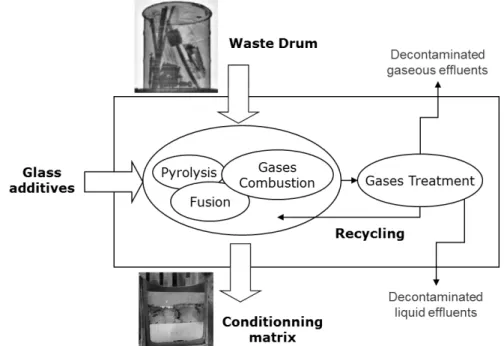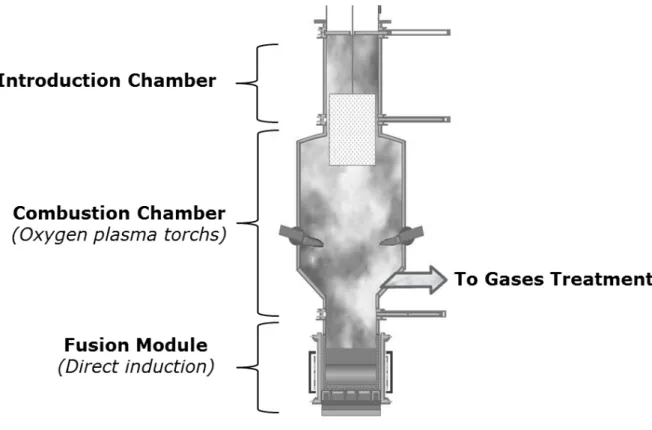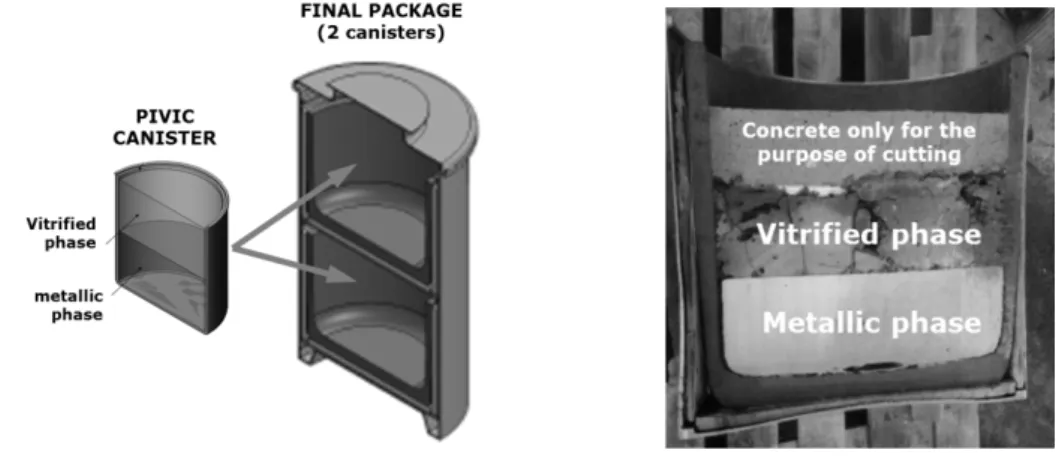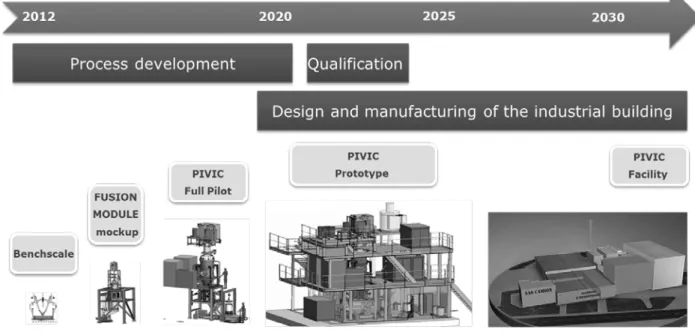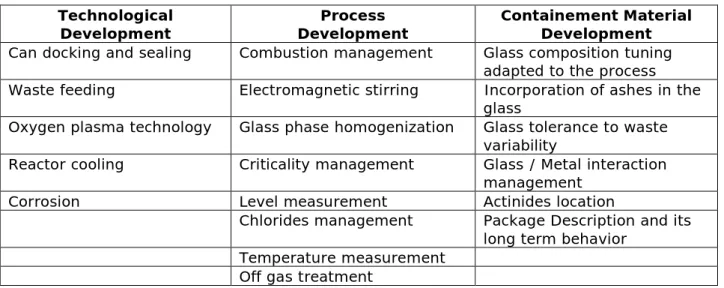HAL Id: cea-02437089
https://hal-cea.archives-ouvertes.fr/cea-02437089
Submitted on 13 Jan 2020HAL is a multi-disciplinary open access archive for the deposit and dissemination of sci-entific research documents, whether they are pub-lished or not. The documents may come from teaching and research institutions in France or abroad, or from public or private research centers.
L’archive ouverte pluridisciplinaire HAL, est destinée au dépôt et à la diffusion de documents scientifiques de niveau recherche, publiés ou non, émanant des établissements d’enseignement et de recherche français ou étrangers, des laboratoires publics ou privés.
Incineration / Vitrification - 17539
C. Girold, P. Charvin, I. Hugon, S. Ben Lagha, S. Catherin
To cite this version:
C. Girold, P. Charvin, I. Hugon, S. Ben Lagha, S. Catherin. Mixed Metallic and Organic Transuranic Waste Incineration / Vitrification - 17539. WM2017 - Waste Management Conference, Mar 2017, Phoenix, United States. �cea-02437089�
Mixed Metallic and Organic Transuranic Waste Incineration / Vitrification - 17539
Christophe GIROLD*, Patrice CHARVIN*, Isabelle HUGON*, Sabah BEN LAGHA+, Stéphane CATHERIN°
* Commissariat à l’Énergie Atomique, Nuclear Energy Division Waste Treatment and Conditioning Research Department
CEA, DEN, DTCD
CEA-AREVA Joint Vitrification Lab 30207 Bagnols-sur-Cèze Cedex, France
+ AREVA NC, Business Unit Recycling
Tour AREVA - 1 place Jean Millier 92084 Paris La Défense Cédex
° National Radioactive Waste Management Agency (ANDRA) Research and Development Division, Waste Packages and Material Department
1-7, rue Jean-Monnet - 92298 Châtenay-Malabry Cédex - FRANCE ABSTRACT
Transuranic wastes are produced by the nuclear fuel cycle management, essentially from MOX fuel production units. These waste, contaminated with Uranium and Plutonium, have large composition variability and enclose, in current temporary conditioning, mixed metals and organics. Metals are mainly stainless steel, aluminum or copper and organics are composed of different kind of plastics, highly chlorinated for some.
On purpose, a new treatment process is being studied to incinerate the organics, melt the metallic fraction and incorporate the mineral residue fraction in a glass matrix. This paper presents the outlines of the process feasibility studies: waste main characteristics, process specifications and main technical options, R&D strategy, mixed glass / metal package description, basic studies needed to develop the process and the matrix (glass/metal redox reactions, actinides partitioning …). INTRODUCTION
The alpha technological wastes (PCM, Plutonium Contaminated Material) are produced during the operation of glove boxes in which are handled MOX powders and pellets for fuel manufacturing. Their characteristic is to contain a mixture of organic elements, metal and mineral materials contaminated with uranium, plutonium and americium. One scenario under study is to process the waste before disposal in deep geological formations. It consists in the mineralization of organics and in the stabilization of mineral and metal fractions of the waste.
Among the considered options, thermal processes are capable of achieving the mineralization of all organic material while fusing the mineral and metal fractions. This is to develop such a process and the associated vitrified packaging material that a Research program was developed: PIVIC (Process for Incineration and Vitrification In Can). PIVIC is an innovative packaging process responding to a complex issue: the critical specification to recover the wastes without prior sorting
or pretreatment. PIVIC will produce a multiphasic glass / metal package conditioning the actinides, without organic material.
PIVIC PROJECT SCOPE AND OBJECTIVES
The Transuranic Mixed Metallic and Organic Waste
The PIVIC process will have to treat technological wastes containing organic and metallic waste contaminated with alpha emitter elements. These wastes mainly come from MOX fuel production units in France (Melox) but also from AREVA spent fuel reprocessing plants (La Hague). They are mainly generated by the process operations and the maintenance of those facilities.
In the existing process, these wastes are packaged in drums of 118 or 120 L, and are mainly put in interim storage at La Hague. Currently the wastes are source-separated and are collected in a selective way according to their “families”. The different families are:
• Organic wastes: gloves from glove boxes, wipes, windows of glove boxes, plastics (PVC…).
• Metallic wastes and various elements: electric equipments, defective mechanical products, tooling …
• Filters: first filtration barrier, second filtration barrier, grinding machine pre-filters, labs filters …
Organic wastes are present in all drums because of a technical producing requirement. Indeed, to assure the protection of the employees and the containment of radioactive materials, the wastes must be bring out of glove boxes in a double welded bag (PVC).
Industrial Specifications and Technical Challenges
Following some preliminary studies, a new and innovative way of management has been chosen by Areva, in partnership with CEA and Andra. The new conditioning process has to follow some requirements:
• Full destruction of organic matter • Confinement of the radionuclides
• No pre-treatment (the drums will not be opened and not sort out) • The process will have to reduce the waste volume
• The final package has to be compliant with final disposal
Regarding these requirements, the PIVIC process has been selected and is under development. It will incinerate the organics, melt the metallic fraction and incorporate the mineral residue fraction in a glass matrix so as to obtain the PIVIC package (see Process Description part for more details).
The industrial PIVIC process is planned to start operations in 2042. At this date, around 30,000 drums should be produced. With a mean rate of 2,000 drums treated per year, the PIVIC process should produce 100 packages per year.
Expected Benefits of Incineration / Vitrification
This new process has number of expected benefits, listed hereafter:
• Provide better safety in final disposal thanks to the removal of reactive material (organic material are mineralized) and to the production of a stable matrix (two phase matrix: the upper one is glass, the lower one is metal).
• The actinides are stabilized in a solid matrix. • The waste is treated in a single step process.
• Preserve disposal resources thanks to a noticeable reduction of the volume of actual waste packaging to be disposed of (volume reduction up to 7).
• Offer a new option of management for soft operational waste (incl. PCM) in France but also in other countries.
THE PIVIC PROCESS Process Description
The purpose of this process is to achieve, in a single reactor, the pyrolysis of the organic fraction of the waste, followed by the full combustion of gases, the fusion of the metallic fraction, and the incorporation of the ashes coming from incinerated organics in a glass matrix (figure 1).
To comply with operation in contaminated environment, the following basics requirements guided the PIVIC design:
• A limited number of apparatus, • A process as compact as possible,
• A minimum inlet of gas to minimize the size of gas treatment equipment, • A minimum generation of secondary waste,
• A resistance to aggressive corrosion.
Main development constraints (the most dimensioning being no sorting and/or grinding of waste) resulted in retaining a process decoupled in a lower part ensuring the fusion function and an upper part providing the combustion of the organic. This set schematically shown in Figure 2 has the characteristics described below.
Fig. 2. Heart of the PIVIC process schematic diagram.
Direct feeding without preprocessing:
This arrangement requires significant process flexibility since a wide range of waste, organic, inorganic or metal may be introduced into the process. The feeding mode selected is the gradual lowering of the load to the bottom of the reactor. Pyrolysis of organic is mastered by the position of the load. Then, after complete combustion, it is deposited in the crucible.
Pure oxygen plasma combustion:
The combustion of the waste is obtained thanks to a pure oxygen plasma torch. This concept of coupling induction and plasma heating ensures optimization of the thermal power required, firstly to burn the organic fraction of the waste, secondly to elaborate the biphasic material.
The use of oxygen instead of air (conventionally used in incineration) can substantially reduce the volume of gas in the process and thus reduce the size of gas treatment equipment. The use of pure oxygen supplied in the form of plasma also optimizes combustion kinetics and therefore the waste residence time before complete oxidation.
The performances of total combustion of the gas in this case are likely to be sufficient to avoid a post-combustion step in the treatment of gases [5]. In the next steps of gas treatment, the gas cooling is provided by simple dilution in order to simplify the system and consequently the cleaning operations; prefiltration gas process benefits from developments in electro filtration to limit point losses and the production of secondary waste. The dust retained by the electro filter will be recycled in the process.
In can melting:
The characteristic of the IN CAN MELTING is to use the elaborating crucible as the final container. This crucible is used as a part of the process (the oven for fusion) for all the duration of its filling. In the case of PIVIC, the filling time is evaluated to be less than 48h. This configuration simplifies the control devices, the maintenance and minimizes corrosion problems; unlike other technologies, it more easily accommodates a biphasic metal / glass content.
A metallic / glass biphasic package:
The process is not designed to perform the oxidation of metals present in waste and this is not a requirement. This leads to the production of a biphasic package with metal at the bottom and glass as a supernatant due to the difference in density. This new characteristic involves new knowledge requirements to optimize the glass composition and to describe the produced package: interactions between glass and metal [1], localization of actinides in the package and long-term behavior of the full package including metallic fraction [2].
From a material point of view, an aluminosilicate glass has been preferred [3] to more conventional borosilicate glass, because of the volatility of boron at high temperature (stainless steel must be heated up to 1450°C to melt).
The final package is constituted by stacking two PIVIC canisters in a container (figure 3).
Fig. 3. PIVIC Package concept and vertical cut of a scale 1 canister produced with the first prototype of the project.
Low frequency induction melting:
The power deposition to melt the metal is obtained by means of a low-frequency induction device through a multilayer wall partially metallic and internally lined with ceramic [4]. This heating method ensures electromagnetic stirring of the metal that drags along the glass phase; it is then not necessary to resort to a mechanical homogenization system.
R&D DEVOLOPMENT PLAN Strategy
For the development and the qualification of the process and the package, a strategy of using inactive full scale prototypes has been chosen, technologically as close as possible to an industrial nuclearized release. Full scale prototypes are essential for the development of thermal processes and their similarity to the final design of the plant will save time for engineering studies.
These tools are some particularly structuring elements for the project from the point of view of planning (construction and implementation), the validation process or the associated budget.
Figure 4 shows the evolution of the tools used in the project. Each tool is specifically associated with a project phase. The complexity of tools is gradual, and goes as far as the final prototype which is similar to the final process. From the fusion module, each new tool is an evolution of the previous one. This deployment mode allows optimization and smoothing of investment.
The project is divided into four gradual development phases (Figure 5):
• Phase 1: Specify the input data and establish the basic concepts of the process • Phase 2: Demonstrate the feasibility of concepts
• Phase 3: Develop the full process • Phase 4: Qualify the process
Fig. 4. Structuring tools of the PIVIC Project.
Main themes of R&D
From a functional analysis coupled with a risks analysis, a R&D development plan was built to provide all the necessary informations for the industrial process data book and the waste package description for safety authorities. This plan is divided into three main areas (Table 1): technological development, process development and containment material development.
TABLE I. Main themes of R&D
Technological
Development Development Process Containement Material Development
Can docking and sealing Combustion management Glass composition tuning adapted to the process Waste feeding Electromagnetic stirring Incorporation of ashes in the
glass
Oxygen plasma technology Glass phase homogenization Glass tolerance to waste variability
Reactor cooling Criticality management Glass / Metal interaction management
Corrosion Level measurement Actinides location
Chlorides management Package Description and its long term behavior
Temperature measurement Off gas treatment
State of the R & D 2016
The R&D started in 2011 with paper work, lab scale tests and mockup. The first mockup (fusion module) was started in 2014 and is still under exploitation. Below are the significant achievements of the R&D program:
• The IN CAN low frequency induction melting concept of a biphasic material has been validated with the elaboration of twenty canisters of roughly 200 kg of metallic alloy made of stainless/copper/Aluminum (melting temperature ~ 1450 °C) and 50 kg of glass (melting temperature ~1250 °C). The canister is correctly cooled and the internal ceramic liner has sufficient corrosion resistance both to the glass and metal phases.
• The metallic fraction is strongly agitated by the electromagnetic forces. As an example, the surface velocity is around 0.1 m.s-1. The glass phase is also
correctly agitated, being dragged by the molten metal, the surface velocity is around 0.01 m.s-1.
• An aluminosilicate glass composition has been developed incorporating 15 % of ashes from the organic fraction of the waste. During elaboration, the ashes incorporation is fast due to the good agitation.
• The package has good macroscopic separation of glass and metal phases (figure 3). In the absence of aluminum in the metals, the glass is homogeneous with a low enrichment of oxidized steel elements (Cr, Mn and Fe) which can crystallize at high concentrations. High concentrations of aluminum in the metals
lead to a more crystalline oxide phase since the aluminum is fully oxidized by the glass phase.
• The simulants of the actinides are exclusively found in oxides form, dissolved in the glass or in the form of silicates in the case of high concentrations of aluminum.
• Thanks to an oxygen plasma mockup, the feasibility to manage the combustion of the organics by the selected feeding mode (gradual lowering of the load to the bottom of the reactor) has been validated.
• Early studies, based on thermal / hydrodynamic modeling and plasma benchscale with surrogates has shown that the plutonium retention rate will be low enough to be compatible with industrial exploitation.
CONCLUSION AND PERSPECTIVES
Early studies and first tests on bench scale and mockup have demonstrated the feasibility of the concept to treat mixed organics and metallic alpha waste by, incorporate simulated mineral fraction in a glassy material and melt the metallic part, using induction heating.
Thanks to the good results obtain during the first two phases of the PIVIC project; the project is now leaving the phase 2 to enter the phase 3 with the building of the full pilot which is planned to be available in 2018. The next tests will permit to demonstrate the faisability of the full process including incineration part.
REFERENCES
1. Pierrick CHEUVREUX, Anabelle LAPLACE, Etienne DELOULE, Laurent TISSANDIER, « Interactions between an aluminosilicate glass melt and molten metals investigated by SEM analysis for a nuclear issue”, Glass and Optical Materials Division meeting, Madison - USA (2016).
2. Anabelle LAPLACE, Stéphane GOSSE, Isabelle HUGON, Théodore COZZIKA, “Modelling of a metallic phase coming from nuclear waste after high temperature treatment”, MRS Scientific Bases for Nuclear Waste Management, Montpellier – France (2015).
3. Damien PERRET, Isabelle HUGON, Olivier PINET, Patrice CHARVIN, Florent LEMONT, “Glass formulation approach for mixed nuclear waste treatment using PIVIC incineration-vitrification in can process”, Glass Science and Technology Conference, Sheffield - UK (2016).
4. Patrice CHARVIN, Florent LEMONT, Aldo RUSSELLO, Arnaud QUINTAS, “Innovative glass melting and stirring process via molten metal”, Glass Science and Technology Conference, Sheffield – UK (2016).
5. Arnaud QUINTAS, “Comparative assessment of plasma torch technologies for incineration reactor through numerical modeling”, 27th Symposium on Plasma Physics
and Technology, Prague - Czech Republic (2016).
ACKNOWLEDGEMENTS
The PIVIC project is a partnership between Areva, CEA and Andra. It is supported by the French government program “Programme d’Investissements d’Avenir” whose management has been entrusted to Andra.
